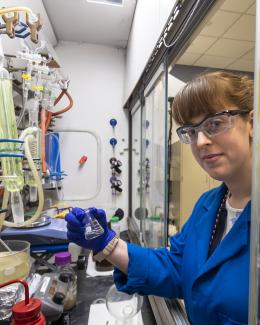Abstract
Enzymatic biodegradation of polymers, such as polyamides (PA), has the potential to cost-effectively reduce plastic waste, but enhancements in degradation efficiency are needed. Engineering enzymes through directed evolution is one pathway toward identification of critical domains needed for improving activity. However, screening such enzymatic libraries (100s-to-1000s of samples) is time-consuming. Here we demonstrate the use of robotic autosampler (PAL) and immediate drop on demand technology (I.DOT) liquid handling systems coupled with open-port sampling interface-mass spectrometry (OPSI-MS) to screen for PA6 and PA66 hydrolysis by 6-aminohexanoate-oligomer endo-hydrolase (nylon hydrolase, NylC) in a high-throughput (8–20 s/sample) manner. The OPSI-MS technique required minimal sample preparation and was amenable to 96-well plate formats for automated processing. Enzymatic hydrolysis of PA characteristically produced soluble linear oligomer products that could be identified by OPSI-MS. Incubation temperatures and times were optimized for PA6 (65 °C, 24 h) and PA66 (75 °C, 24 h) over 108 experiments. In addition, the I.DOT/OPSI-MS quantified production of PA6 linear dimer (8.3 ± 1.6 μg/mL) and PA66 linear monomer (13.5 ± 1.5 μg/mL) by NylC with a lower limit of detection of 0.029 and 0.032 μg/mL, respectively. For PA6 and PA66, linear oligomer production corresponded to 0.096 ± 0.018% and 0.204 ± 0.028% conversion of dry pellet mass, respectively. The developed methodology is expected to be utilized to assess enzymatic hydrolysis of engineered enzyme libraries, comprising hundreds to thousands of individual samples.







